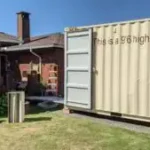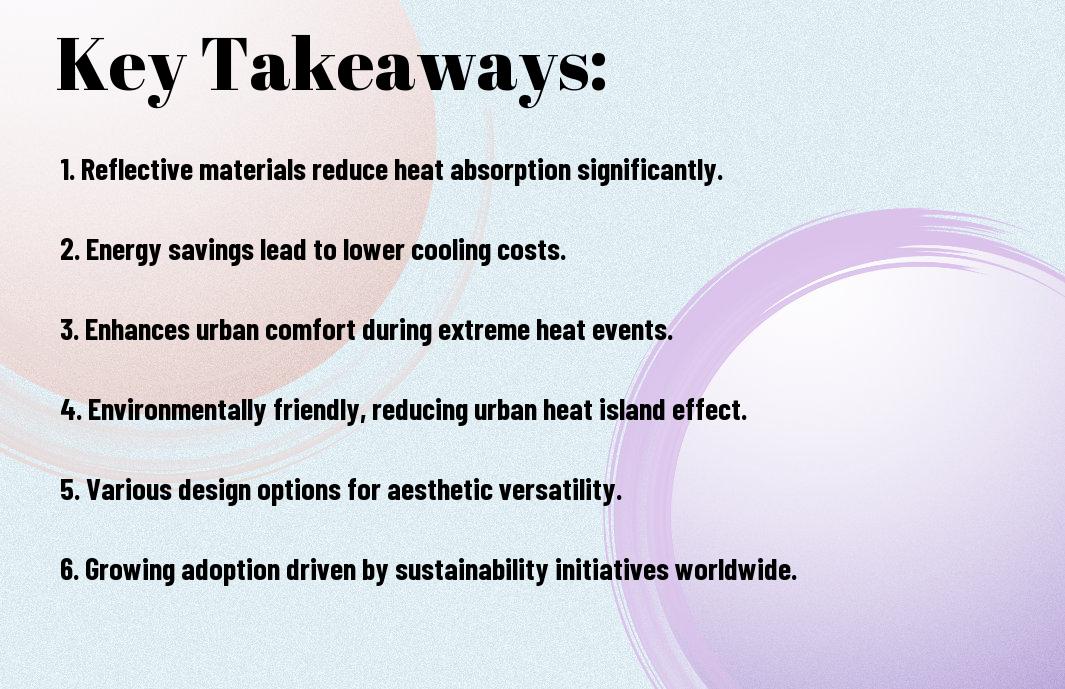With the increasing concerns about climate change and energy efficiency, cool roofing has emerged as a vital solution for homeowners and businesses alike. You may be wondering how these innovative roofing systems can benefit you by reducing energy costs, improving indoor comfort, and contributing to sustainability. In this blog post, we will explore the advantages of cool roofing and the latest trends shaping this growing industry, equipping you with the knowledge to make informed decisions for your property.
Key Takeaways:
- Cool roofing systems reflect more sunlight and absorb less heat, leading to lower energy costs and improved indoor comfort, particularly in warmer climates.
- Adoption of cool roofing materials is accelerating due to increasing awareness of their environmental benefits, such as reducing urban heat islands and lowering greenhouse gas emissions.
- Innovative trends in cool roofing, including advanced coatings and environmentally friendly materials, are expanding market options and enhancing performance for various building types.
Understanding Cool Roofing
Your awareness of cool roofing can significantly impact your energy bills, comfort, and environmental footprint. Cool roofing is designed to reflect more sunlight and absorb less heat than standard roofing materials, resulting in lower roof temperatures and energy costs. As climate change drives the need for sustainable building practices, cool roofing emerges as an effective solution for urban areas faced with heat island effects.
What is Cool Roofing?
About cool roofing, it refers to a variety of roofing systems that aim to maintain a lower temperature compared to traditional roofs. These roofs achieve this by utilizing reflective materials and coatings, which help to lower energy consumption for air conditioning and improve indoor comfort levels.
Types of Cool Roofing Materials
A diverse selection of materials can be used for cool roofing. Each type offers unique benefits and characteristics, making them suitable for different building applications. Here’s a breakdown:
| Material | Key Features |
| Reflective Shingles | High solar reflectance and durability. |
| Cool Membranes | Single-ply roofing with excellent heat reflectance. |
| Green Roofs | Plants and soil absorb heat and provide insulation. |
| Metal Roofs | Excellent reflective capabilities; robust and long-lasting. |
| TPO and PVC | Durable, energy-efficient membranes with reflective properties. |
This variety allows you to choose the best option for your specific roofing needs and climate. Investing in cool roofing materials can lead to immense long-term savings and a reduced carbon footprint.
More on Cool Roofing Materials
A deeper understanding of cool roofing materials enables you to make informed decisions for your home or commercial building. Each cool roofing type has specific advantages catering to different installation and budget considerations. Additionally, energy efficiency standards influence which materials are best suited for your project:
| Material Type | Advantages |
| Shingles | Widely available and easy to install. |
| Membranes | Significantly reduces cooling costs. |
| Green Systems | Enhances aesthetic value and biodiversity. |
| Metal | Resilient against extreme weather conditions. |
| Foam Insulation | Creative applications ensure high reflectivity. |
This array of options allows you to select cool roofing materials tailored to your preferences and environmental goals.
Benefits of Cool Roofing
Assuming you’re considering upgrading your roofing system, the advantages of cool roofing are numerous. This innovative technology contributes to lower energy consumption, enhances comfort within your living space, and can even increase the lifespan of your roof. Additionally, these roofs reflect more sunlight and absorb less heat, promoting a cooler indoor environment and significantly reducing your air conditioning costs. Overall, investing in cool roofing is not just about aesthetics; it’s a smart choice for both efficiency and comfort in your home.
Energy Efficiency and Cost Savings
Below, you’ll find that one of the standout features of cool roofing is its remarkable energy efficiency, translating into substantial cost savings. By utilizing reflective materials, cool roofs can lower roof surface temperatures, reducing the need for excessive air conditioning. This can lead to lower utility bills, allowing you to save money while enjoying a more temperate indoor climate year-round.
Environmental Impact
Roofing materials that promote sustainability offer great environmental benefits. By choosing a cool roof, you are not only reflecting sunlight but also significantly contributing to the reduction of urban heat islands, which can lead to lower overall temperatures in metropolitan areas. This results in improved air quality and reduced greenhouse gas emissions, creating a healthier environment for your community.
Benefits of cool roofing extend beyond personal savings; they offer an opportunity for you to make an environmentally friendly choice. Opting for these roofs can help reduce energy consumption and your carbon footprint, playing a vital role in the fight against climate change. By investing in your roof, you’re not just enhancing your home’s comfort; you’re actively participating in the sustainability movement, benefitting both yourself and the planet.
Trends in the Cool Roofing Industry
To stay competitive, the cool roofing industry is evolving rapidly, embracing new materials and techniques that enhance performance and sustainability. You can expect to see a growing preference for reflective materials, as well as eco-friendly options that not only minimize heat absorption but also meet strict environmental standards. As concerns about climate change rise, these trends are shaping how businesses and homeowners alike are adopting cool roofing solutions.
Technological Innovations
Any significant advancement in the cool roofing sector comes from innovative technologies that improve energy efficiency and durability. New forms of reflective coatings, smart roofing systems, and integrated insulation materials are making it possible for you to select roofing options designed to withstand extreme weather conditions while significantly reducing cooling costs. These innovations are key in making cool roofing more accessible and effective for everyone.
Market Growth and Adoption Rates
Innovations in cool roofing have sparked remarkable market growth and increased adoption rates among both residential and commercial consumers. As awareness about the benefits of cool roofing spreads, you will likely notice more local regulations and incentives aimed at promoting these environmentally friendly solutions. This demand is pushing manufacturers to continuously improve their product offerings, ensuring that you have access to the latest advancements in roofing technology.
In addition, the rising focus on energy efficiency and sustainability has led to greater acceptance of cool roofing materials in various sectors. As building owners and homeowners recognize the long-term savings and environmental impact, you can expect significant market expansion. Research indicates that by 2025, cool roofing materials will make up an even larger share of the total roofing market, highlighting the industry’s commitment to integrating climate-responsive solutions. This trend not only benefits you but also contributes positively to the broader efforts of combating climate change.
Installation and Maintenance Considerations
Keep in mind that proper installation and maintenance are necessary for maximizing the performance of cool roofing systems. It’s important to work with experienced professionals who understand the unique requirements of cool roofs, ensuring they are installed correctly to yield maximum energy efficiency and longevity. Regular inspections and timely maintenance will help in identifying potential issues early, securing your investment for years to come.
Best Practices for Installation
An effective cool roofing installation starts with assessing the specific needs of your building. Make sure the surface is clean and free of debris, ensuring maximum adherence of the cool roofing materials. You should also consider the climate and orientation of your building to optimize the reflective properties of your roof.
Long-term Maintenance Tips
To keep your cool roofing system in peak condition, conduct regular inspections, clear debris, and address any damage promptly to prevent leaks. Following these simple maintenance steps will ensure efficiency:
- Clearing debris and leaves from the roof surface
- Checking for signs of wear or damage regularly
- Cleaning gutters and drainage systems
After ensuring basic maintenance is done, consider scheduling professional inspections at least once a year. This helps to identify any issues you may not see from the ground.
Even small repairs can significantly extend the lifespan of your cool roof. Maintaining proper insulation and ventilation contributes to its effectiveness. Additionally, you might want to keep records of any maintenance work done to monitor the roof’s condition over time:
- Documenting the dates of inspections and repairs
- Tracking changes in energy consumption pre- and post-installation
- Maintaining communication with your roofing contractor
After implementing these tips, you can enjoy the energy-saving benefits of your cool roofing system for many years.
Regulatory and Incentive Framework
Unlike traditional roofing options, the rise of cool roofing is supported by a growing regulatory and incentive framework that aims to encourage sustainable building practices. Many local governments are implementing codes and standards that require or recommend cool roofing materials in new constructions and retrofits. These regulations are crucial in driving the transition toward energy-efficient solutions and helping you meet environmental goals.
Government Policies Supporting Cool Roofing
Roofing materials that reflect more sunlight and absorb less heat, commonly known as cool roofs, are increasingly promoted through government policies. Legislation at various levels encourages the adoption of these materials by incorporating them into building codes and offering guidelines for energy efficiency. By aligning building practices with sustainability goals, these policies empower you to contribute to a greener environment while enhancing your property’s value.
Financial Incentives for Homeowners and Businesses
At the same time, various financial incentives are available for homeowners and businesses that opt for cool roofing solutions. These may include tax credits, rebates, and grants that can significantly offset your upfront investment. Additionally, some utility companies offer financial programs designed to promote energy efficiency, making it even more attractive to choose cool roofing options.
This financial support can make a significant difference in your decision to invest in a cool roof. Many municipalities also provide flexible financing options for energy-efficient upgrades, making it easier for you to manage costs. With such incentives, adopting cool roofing not only helps in reducing your electricity bills but also aligns with broader environmental initiatives, contributing to the fight against climate change while improving your property’s energy performance.
Case Studies and Success Stories
For those seeking concrete evidence of the advantages of cool roofing, various case studies demonstrate significant benefits. Consider these noteworthy examples:
- Los Angeles, California: Citywide cool roofing initiative led to a 20% reduction in energy costs for residents.
- Baltimore, Maryland: A retrofitted commercial building reported a 30% decrease in cooling energy usage within a year.
- Miami, Florida: Government buildings with cool roofs experienced a lower rooftop temperature by 10°F, improving energy efficiency substantially.
- New York City: A pilot program showed a 15% decrease in urban heat island effect in targeted neighborhoods.
Residential Applications
Case studies of residential applications reveal how homeowners benefit from cool roofing solutions. In neighborhoods where cool roofs were implemented, residents reported lower energy bills and improved indoor comfort during the summer months, showcasing the practicality and effectiveness of such installations.
Commercial Impact
An increasing number of commercial properties are adopting cool roofing technologies, resulting in notable benefits including cost savings and enhanced occupant comfort. Buildings with reflective roof materials have shown an increase in tenant satisfaction due to reduced energy demands and improved climate control.
Studies highlight that businesses have seen an annual energy cost reduction of about 25% on average when implementing cool roofs. Additionally, these roofs extend the lifespan of roofing materials, leading to lower maintenance costs and reinforcing a sustainable building design. With the backing of local governments and financial incentives, investing in cool roofs presents a savvy choice for your commercial property.
Conclusion
As a reminder, the rise of cool roofing offers you significant benefits, including energy savings, enhanced comfort, and reduced urban heat. By choosing reflective materials and adopting the latest trends in roofing technology, you can contribute to a more sustainable environment while enjoying the advantages of lower cooling costs. As the demand for eco-friendly solutions grows, staying informed about cool roofing options will empower you to make better choices for your home and community.
Q: What are the advantages of cool roofing materials compared to traditional roofing options?
A: Cool roofing materials are designed to reflect more sunlight and absorb less heat than traditional roofing products. This reflective property can lead to a lower roof surface temperature, thus reducing the need for air conditioning in buildings. As a result, building owners often see significant energy cost savings over time. Additionally, cooler roofs can contribute to a lower urban heat island effect, improve indoor comfort levels, and increase the lifespan of roofing materials because they experience less thermal stress.
Q: How do cool roofing systems contribute to sustainability and environmental protection?
A: Cool roofing systems promote sustainability by reducing energy consumption, which in turn lowers greenhouse gas emissions associated with electricity generation. Furthermore, by mitigating the urban heat island effect, cool roofs can improve local air quality and lessen the demand for energy resources, contributing to better environmental health. Many cool roofing materials are also made from recycled or sustainable sources, which supports eco-friendly construction practices and encourages the circular economy.
Q: What trends are emerging in the cool roofing industry as awareness of its benefits grows?
A: The cool roofing industry is witnessing a surge in innovations, including the development of advanced reflective coatings and materials that enhance energy efficiency. There is also a growing interest in integrating cool roofing with other sustainable building practices, such as green roofs and solar panel installations. Additionally, regulatory changes and incentives are encouraging broader adoption of cool roofing solutions, leading to increased collaboration between government agencies, manufacturers, and building owners to prioritize energy-efficient construction.






